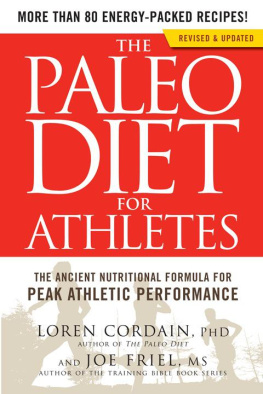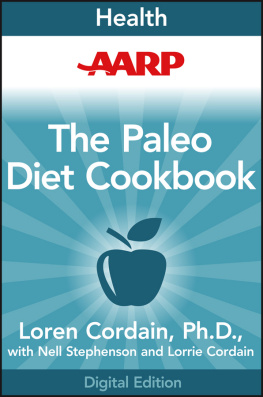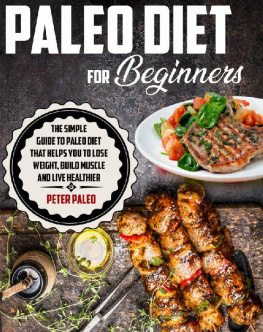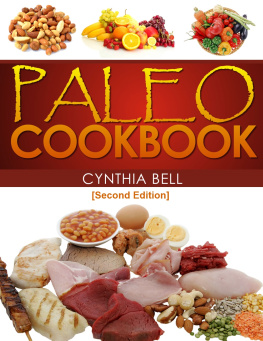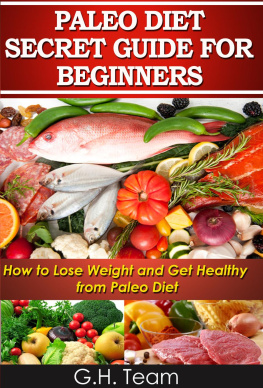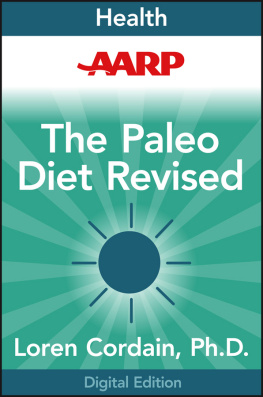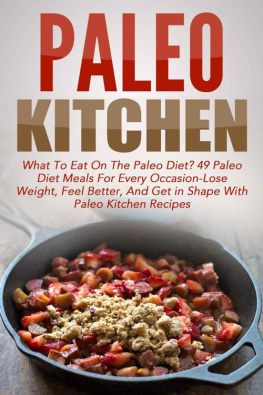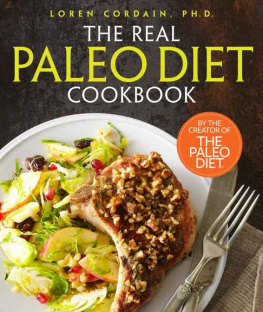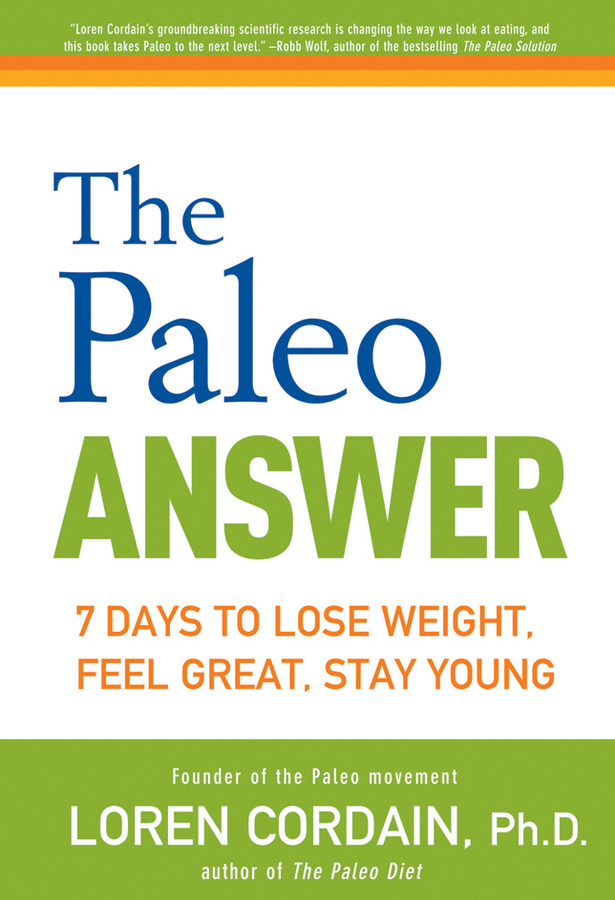Contents
Also by Loren Cordain
The Paleo Diet
The Paleo Diet Cookbook (with Lorrie Cordain and Nell Stephenson)
The Paleo Diet for Athletes (with Joe Friel)
The Dietary Cure for Acne

Copyright 2012 by Loren Cordain. All rights reserved
Published by John Wiley & Sons, Inc., Hoboken, New Jersey
Published simultaneously in Canada
No part of this publication may be reproduced, stored in a retrieval system, or transmitted in any form or by any means, electronic, mechanical, photocopying, recording, scanning, or otherwise, except as permitted under Section 107 or 108 of the 1976 United States Copyright Act, without either the prior written permission of the Publisher, or authorization through payment of the appropriate per-copy fee to the Copyright Clearance Center, 222 Rosewood Drive, Danvers, MA 01923, (978) 750-8400, fax (978) 646-8600, or on the web at www.copyright.com . Requests to the Publisher for permission should be addressed to the Permissions Department, John Wiley & Sons, Inc., 111 River Street, Hoboken, NJ 07030, (201) 748-6011, fax (201) 748-6008, or online at http://www.wiley.com/go/permissions .
The information contained in this book is not intended to serve as a replacement for professional medical advice. Any use of the information in this book is at the readers discretion. The author and the publisher specifically disclaim any and all liability arising directly or indirectly from the use or application of any information contained in this book. A health care professional should be consulted regarding your specific situation.
For general information about our other products and services, please contact our Customer Care Department within the United States at (800) 762-2974, outside the United States at (317) 572-3993 or fax (317) 572-4002.
Wiley also publishes its books in a variety of electronic formats and by print-on-demand. Some content that appears in standard print versions of this book may not be available in other formats. For more information about Wiley products, visit us at www.wiley.com .
ISBN 978-1-118-01608-4 (cloth); ISBN 978-1-118-16009-1 (ebk);
ISBN 978-1-118-16010-7 (ebk); ISBN 978-1-118-16011-4 (ebk)
For Lorrie and the Boys
Preface
I think its important to give you a history of the Paleo Diet concept. The Paleo Diet and Paleo in general have recently become very hot topics. These ideas have become household words in the last few years; however, it hasnt always been this way. On the next page is a graph from Google Trends for the words Paleo Diet.
Its clear from this graph that the Paleo Diet was unknown to all but dedicated fans until three years ago. Fortunately, Ive been in the middle of this worldwide movement nearly from its beginnings.
Last October, I approached my sixtieth birthday with some trepidation. I was part of the 1960s generation whose mantra was not to trust anyone over thirty, and now Im twice that age. As I look back over my life, I can pinpoint a few key events that led me to discover and appreciate the Paleo Diet.
I came of age as a track and field athlete at the University of Nevada, Reno, in the late 1960s and the early 1970s, and I was always interested in diet, fitness, and athletic performance. Later as lifeguards at Lake Tahoe, my friends and I read all of the now-classic vegetarian diet and health books such as Francis Moore Lapps Diet for a Small Planet , Paivo Airolas Are You Confused? and Dick Gregorys Natural Diet for Folks Who Eat , among others. I attended a Dick Gregory lecture in Seattle and got to shake the famous comedians hand. My lifeguard friends and I experimented with vegan diets, fasting, and all kinds of vitamins and supplements. Almost everyone seemed to own a juicer.
Google Trends Search for Paleo Diet

Each summer, instead of shying away from the sun and using sunscreens, we all tried to get the deepest tans possible. We swam in Tahoes icy, invigorating, nonchlorinated waters, and decades before Vibram Five Fingers and Nike Frees (shoes that mimic bare feet) were the rage, we ran barefoot in the sand along Sand Harbors pristine shoreline. Those twenty memorable summers as a lifeguard at Tahoe heightened my awareness of the outdoor, natural world, sunshine, health, fitness, and diet.
I completed my Ph.D. in exercise physiology at the University of Utah in the spring of 1981 and was promptly hired as an assistant professor in the Department of Health and Exercise Science at Colorado State University. For the first five to ten years of my career, my research focused mainly on how diet and exercise affected fitness and athletic performance. I still hadnt encountered Paleo, but I read widely and had a considerable interest in anthropology.
In the spring of 1987, I happened upon Boyd Eaton, M.D.s now-classic scientific paper Paleolithic Nutrition: A Consideration of Its Nature and Current Implications, which had been published two years earlier in the prestigious New England Journal of Medicine . This article made a lasting impression on me; it was the single factor that caused me to focus my research interests on ancestral human diets from that point forward.
One of the surprising points that Dr. Eaton made in a subsequent paper was that cereal grains were rarely or never consumed by pre-agricultural hunter-gatherers.
In the days and months after reading Boyds groundbreaking paper, I became engrossed in studying ancestral human diets, and I voraciously read everything I could about the topic. At first, I simply filed all of the scientific papers and documents into a single file folder I labeled Paleolithic Nutrition. Early on, I realized that this strategy wouldnt work because of the enormous volume and diversity of topics that materialized.
As I read more and more, patterns began to emerge. Stone Age people did not drink milk or consume dairy products. So I created a file folder labeled Dairy. They also didnt eat cereal grains, as Dr. Eaton pointed out, so I created a single file folder called Cereal Grains. Just like the single folder I had originally created for Paleolithic Nutrition, it soon became apparent that the topic of cereal grains and their potential for adversely affecting health was an enormous topic that ultimately would require a huge number of file folders.
Eating Paleo
As my lifeguarding days drew to a close in 1991, my wife, Lorrie, and I began to eat Paleo. During the course of the next seven or eight years, I collected more than twenty-five thousand scientific papers and filled five large filing cabinetseach with hundreds of categories dealing with all aspects of the Paleo Diet and the Paleo lifestyle. In 1994, I mustered enough courage to telephone (no one used e-mail then) the man who was responsible for my collection of articles on anything and everything related to Paleo. Dr. Eaton is a true gentleman and a scholar in every sense of the word. We spoke for almost an hour on that first telephone call. He gave me one of the greatest compliments of my life at the end of the conversation when he said, It sounds to me like you know more about this than I do.
Boyd and I eventually met in 1995, and two years later he invited me to speak with him at an international conference on fitness and diet organized by Dr. Artemis Simopoulos in Athens, Greece. Artemis was a wonderful hostess for the conference, and during my two-week stay in Greece, we had many conversations about diet and health. I mentioned that I had written a partially completed manuscript on the nutritional shortcomings of cereal grains. About a year later, she asked me if I could complete the paper and submit it for publication in a scientific journal she edited. I did, and the paper Cereal Grains: Humanitys Double Edged Sword, published in 1999, launched my academic career in Paleo nutrition.


